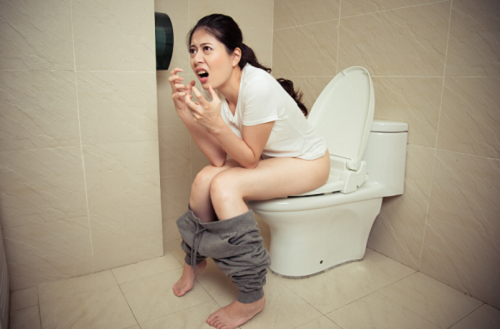It has happened to the best of us –the dreaded toilet water splash. Maybe it happened while you were doing your business, or the toilet had a strong flush, and some toilet water ended up on your face. While it’s gross to even think about it, most people ask, “Can you get std from toilet water splashing?”
The simple answer is, it’s unlikely. Public toilets may harbor many pathogens, but these can only survive in the body. Any virus or bacteria present in the toilet dies almost immediately.
Getting an STD from a toilet is a common misconception, but there’s much more to learn to stay healthy when using public restrooms. Below we’ll discuss why toilets are gross, what diseases can be found in them, how to clean up after a splash, and how to keep safe while using public toilets.
Can You Get STD From Toilet Water Splashing
It’s not uncommon for water to splash on you while using the toilet. But that old wives’ tale about getting an STD from a toilet is untrue. According to the CDC, there has never been a case of one getting an STD from a toilet.
Toilet water is clean when it goes into the toilet bowl. It’s only when the water comes into contact with human waste that it becomes contaminated. But even then, the water in the toilet bowl greatly dilutes the germs.
To understand why you can’t get an STD from the toilet, you first need to understand how STDs are spread. From their name, sexually transmitted diseases, one can only get an STD through vaginal, oral, and anal sex. There are also certain instances when they could be spread through intimate skin-to-skin contact, kissing, and heavy petting.
Secondly, the bacteria, viruses, or parasites that cause STDs require specific conditions to survive. And the toilet environment is not suitable, meaning the pathogens will die almost immediately. Let’s look at other FAQs about public toilet water splashed on me:
Can You Get an STD From Urine on a Toilet Seat?
As mentioned above, organisms that cause STDs can’t live long or thrive on cold, non-porous surfaces like a toilet seat, much less outside the body. For this reason, it’s nearly impossible to get an STD from a toilet seat.
For an infection to occur, several conditions would have to be met. First, a transmission would require quick and close contact with bodily fluids. This means you’d have to use the toilet immediately after an infected person before the pathogen dies. Secondly, the pathogen must come in contact with a deep, open sore or wound on your body. The chances of all these conditions being met are next to impossible and only exist in the theoretical sense.
Can You Get Chlamydia from Toilet Water Splash?
The bacteria that cause Chlamydia need to be in a living cell to reproduce. This means they can’t survive outside the human body, so getting Chlamydia from a toilet splash is practically impossible.
Can You Get AIDS From Toilet Water?
The virus that causes AIDS needs a warm host to survive, and the toilet water or seat doesn’t provide that. For transmission to occur, you’d have to come into close contact with the bodily fluids leaving an HIV-positive person almost instantly. The virus would then have to land on an open wound or exposed mucous membrane to enter the body.
If the bodily fluids are in the toilet water, chances are the water has diluted it to a degree that wouldn’t be enough to cause an infection.
Needless to say, it’s nearly impossible to meet all these conditions, so you don’t have to worry about getting AIDS from toilet water.
Can You Get a UTI From an Unflushed Toilet?

In rare cases, a splash from the toilet or sitting on a dirty toilet seat can cause a UTI. But the bacteria or yeast causing a UTI would have to reach the urethra, which is not common by merely using the toilet.
If you’re worried about backsplash causing a UTI, you can take precautions like putting a few rolls of toilet paper on the water to prevent splashing.
That being said, note that a UTI infection in the toilet is commonly caused by wiping from the anal region to the urethra instead of the other way around.
What Diseases Are Transmitted by Public Toilets?
Aside from STDs, several other germs sit in toilets that you should worry about, such as:
- Escherichia coli, E. coli
- Gastrointestinal viruses like norovirus
- Shigella bacteria
- Streptococcus
- Staphylococcus
The majority of these microbes can be transmitted through vomit or fecal matter. The good news is no one in their right mind would sit on a toilet seat with vomit or fecal matter. Also, most of these disease-causing organisms can only live a short time on the cold and hard toilet seat surface.
An infection can only occur if the germs get to your urethra or genital tract or through an open wound or sore. As you can see, many variables need to come in place for you to get an infection from toilet seats and water splashes.
As mentioned earlier, germs in toilets are common in our environment. In fact, the chances of getting them from your phone, keys, doorknobs, and water facets are much higher than sitting on a toilet. Without good hygiene, our hands are far filthier than a toilet seat.
Is It Safe to Sit on Public Toilet Seats?
Of course, there are many pathogens in toilets, but most of these germs are common skim microbes that we already have. What’s important is to thoroughly wash your hands after using the toilet.
While your bum may be touching the toilet seat, your skin is a barrier to keeping germs away. And the only way an infection will occur is if you have an open wound that germs could enter.
What to Do When Toilet Water Splashes on You?
Toilet water on your body is gross and uncomfortable. And while it may not cause an STD, the water could still be contaminated with urine or fecal matter.
First off, don’t panic. The most important thing is immediately cleaning the area with soap and water. You can even use antibacterial wipes, especially in a public toilet. Cleaning the area will help disinfect and prevent bacteria from entering your body.
If the contaminated water splashes in your eyes or mouth, rinse thoroughly with water. Afterwards, watch out for any signs of infection.
How Do You Prevent Infection in Public Toilets?
While it’s rare to get an infection from public toilets, there are still ways to limit contact with bacteria in the toilet.
- You can start by wiping down the toilet seat in a public restroom before using it. And sit carefully to avoid your genitals touching the seat.
- But the most crucial tip is thoroughly washing your hands after using the toilet. Ensure you use soapy water and thoroughly scrub your hand, fingers, and under fingernails (preferably for about 20-30 seconds). Then rinse thoroughly as well. Be sure to use a tissue paper/paper towel to shut off the faucet and door handles to prevent contamination.
- The way you dry your hands also matters. It’s better to use paper towels than air driers since the latter spreads germs even more.
- It’s also important to flush the toilet with the lid down to prevent germs in feces from being propelled into the air.
So, Can You Get STD From Toilet Water Splashing
We can all agree that public toilets are gross, but getting std from toilet water splashing is unlikely. If you get splashed, just use soap and water or sanitizing wipes to clean up. That being said, picking up pathogens from toilet surfaces is still possible, hence the hand-washing rule. We hope this content has helped ease your mind, especially when using public toilets.



